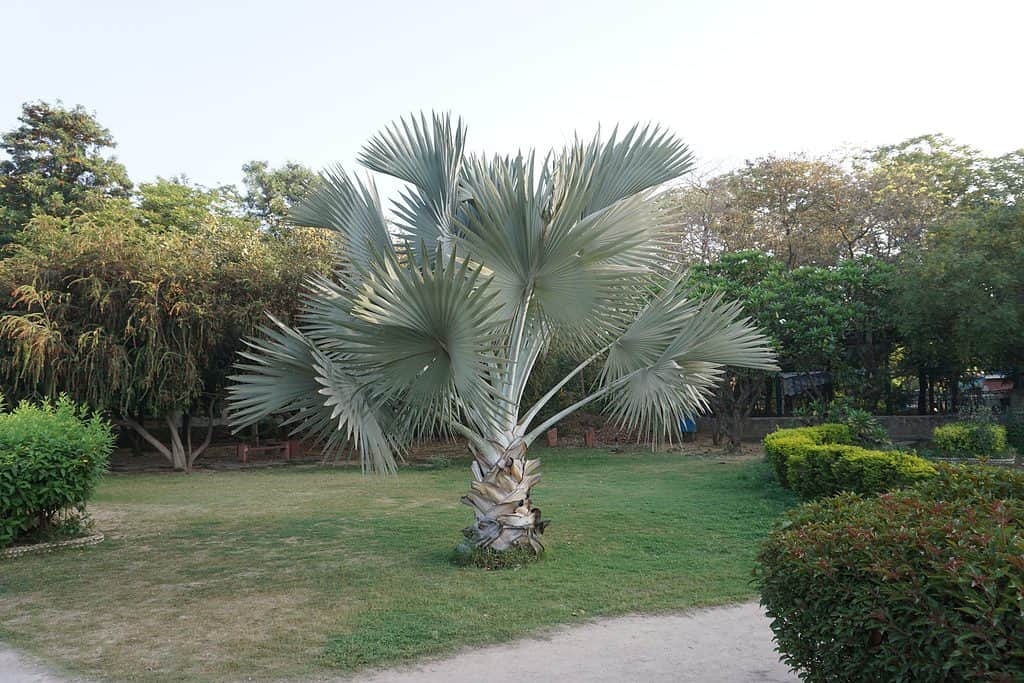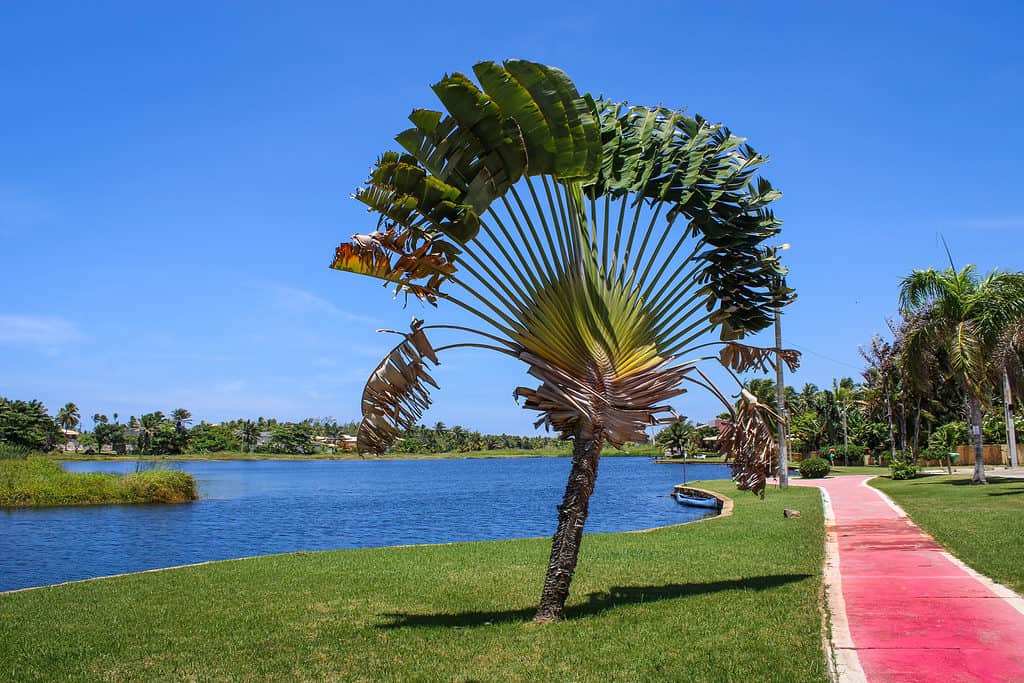Madagascar‘s Flora is one of the most diverse on earth. It has over 10,000 native plant species, and 90% of its native species are endemic. Let’s take a look at 10 incredible trees native to Madagascar.

The za baobab tree is the most widespread in Madagascar.
©Franco Volpato/Shutterstock.com
Where is Madagascar?
The Republic of Madagascar is an island off the southeastern African coast in the Indian Ocean. 30 million people live in its 592,800 square kilometers (228,900 square miles), making it the fourth largest island in the world.
Madagascar has stunning geography ranging from sandy beaches to humid rainforests and towering mountain cliffs. Its stable climate is generally hot and humid, but monsoons and tropical cyclones cause yearly damage.
90 million years ago, Madagascar broke away from the Indian subcontinent. This meant animals and plants evolved in isolation and created a biodiversity hotspot of incredible and unusual lifeforms.
1. Za Baobab (Andasonia Za Baill)

Madagascar is the largest island in
Africa
.
©Vaclav Sebek/Shutterstock.com
There are nine species of the baobab tree in Madagascar, and seven are endemic to the island.
The za baobab has a wide base that narrows at the crown, which can sit 33 to 131 feet (10-40 meters) high. Its thick trunks reach upwards of 20 feet (six meters) wide. Experts think that baobabs store water in their trunks which is why they shrink in the dry months.
Baobab leaves are deciduous and palmately, and trees usually have 5 to 11 leaflets. Their large white flowers open at dusk so quickly that you can see the petals moving! By the following morning, open flowers are spent, but because there are so many, it doesn’t harm the tree’s chance of pollination.
The za baobab tree is the most widespread in Madagascar. It grows in the southern and north-western margins of the main island, where it’s considered sacred by native people.
2. Madagascar Banana Tree (Ensete perrieri Cheesman)
The Madagascar banana tree is endemic to western Madagascar and is on the brink of extinction due to widespread deforestation. Only five known mature trees are left, but scientists hope this banana species will help save the common Cavendish crop banana from widespread fungal diseases.
This rare banana tree has a waxy bluish trunk and a crown of fronds with yellow midribs that resemble a shuttlecock. It grows in stony, dry, tropical forests such as the Tsingy de Bemaraha Strict Nature Reserve. Madagascar National Parks manages this protected reserve to protect endangered flora and fauna.
3. Bismarck Palm (Bismarckia nobilis)

The Bismarck palm is endemic to Madagascar’s north and west environments.
©Vipul1989/Shutterstock.com
The Bismarck palm is an important tree in Madagascar. It’s called satrana and locals use its wood to build homes. Its magnificent green fronds make excellent thatch, mats, and baskets.
These trees can grow to 60 feet (18 meters) and spread over 16 feet (five meters). Its trunk appears white, and the fronds are stiff, steely blue. Flowers and fruits cascade from the crown’s base in the hotter months, feeding insects, birds, and small mammals.
This incredible native tree native to Madagascar is impossible to miss and just as beautiful as it is useful.
The Bismarck palm is endemic to Madagascar’s north and west environments but is critically endangered due to forest clearance.
4. Octopus Tree (Didierea madagascariensis Baill)
This odd-sounding tree is endemic to the dry southwestern Madagascan forests. It prefers thorny thickets of undisturbed well-drained soil.
It’s called the Octopus tree because its 1.5-foot trunk is very short, but numerous spiky branches reach upwards to 13-19 feet (4-6 meters), reminiscent of an eight-legged octopus. It’s a succulent type of shrub or tree with sparse deciduous leaves.
The incredible tree is drought resistant and looks like a mass of spike-encrusted branches.
5. Tahina Palm (Tahina spectabilis)
The recently discovered Tahina palm is classified as critically endangered. It’s endemic to northwestern Madagascar and currently conserved at the Mahajanga Reniala Park.
It’s one of Madagascar’s largest palms, reaching 59 feet (18 meters) high with 16 feet (five meters) fronds. Leaf scars adorn the trunk, which stays slim at 20 inches. Its huge inflorescence flowers emerge after 30-50 years and drain the palm of so much energy it dies shortly after.
It grows near limestone hill bases which are seasonally flooded in the wild. This yearly near drowning has earned the tree the title of “suicide palm”!
6. Tapia (Uapaca bojeri Baill)

Tapia’s sweet fruits are valuable resources for the locals and wildlife.
©mikluha_maklai/Shutterstock.com
Tapia is endemic to Madagascar’s central highlands, where it’s one of the main species in dry forests.
It can grow 33-39 feet tall (10-12 meters) but is commonly found at half the height. It has thick, fire-resistant furrowed brown bark with alternate, leathery green oval-shaped leaves on a wide crown.
From March to September, dense balled flowers emerge and mature into drupe fruits up to 1.18 inches long.
Tapia’s sweet fruits and mushrooms which attract wild borocera silkworms, are valuable resources for the locals and wildlife.
7. Rosewood (Dalbergia maritima)
Dalbergia is rosewood, and the species Dalbergia maritima is Madagascar’s rosewood. Despite its name, it’s a species of legume in the Fabaceae family!
This hardwood tree is beautiful and can reach 60 feet in height by 40 feet in width with a crown of bright green oval leaves. The tree’s timber is incredibly beautiful. Madagascan rosewood, called Bois de rose, has a glowing red-purple color loved by woodworkers.
It’s illegally logged due to high demand, and despite a moratorium on trading, illegal logging continues on a large scale.
8. Mangrove Tree (Rhizophora mucronate)

Red mangrove trees are one type found in Madagascar.
©Sean Lema/Shutterstock.com
Madagascar’s mangrove swamps are spectacular, and Rhizophora mucronate is just one of several mangrove trees that make up its incredible ecosystem.
The mangrove swamps are important for migratory birds, fish, crabs, turtles, dugongs, and crocodiles. They are situated in flat coastal areas and need protection from ocean storms. Coral reefs shelter Madagascar’s west coast mangrove swamps.
Rhizophora mucronata is an evergreen tree that reaches 66 to 82 feet high (20-25 meters) but stays shorter nearer the coast. It has incredible aerial roots that act as stilts in the water to keep its trunk high and dry.
Its leaves are elliptical and several inches long with warty undersides. Crabs enjoy eating them! Clusters of cream flowers appear in the warmer months on twig ends.
This tree is useful because it helps prevent coastal erosion, and its fruits are edible. Locals use the tree’s wood to make fish traps and the fruits to make wine. The sad news is mangrove swamps are endangered, being cleared for farming and mineral extraction projects.
9. Ebony (Diospyros gracilipes)

Ebony trees have a dark, almost black timber.
©Damian Pawlos/Shutterstock.com
Diospyros gracilipes trees are more commonly known as ebony. The term ebony comes from their dark, almost black timber. Diospyros gracilipes is one Madagascar’s native ebonies, and it’s under threat from illegal logging.
Madagascar ebony grows in the northern and eastern forests. It’s a fairly small tree compared to rosewood because it only reaches 49 feet (15 meters). It has low branches and smooth brownish-black bark. Ebony is slow growing and tolerates shade, so it enjoys a humid evergreen forest.
It has a rounded crown of alternate, simple leaves, and in spring, small flowers emerge before maturing into an ovoid berry covered in white powder. These berries are a valuable resource for birds and lemurs, which disperse the tree’s seeds across the forest floor.
10. Traveler’s Tree (Ravenala madagascariensis)

Ravenala madagascariensis, known by the common name of the traveler tree, is a tall-stem herbaceous plant endemic to Madagascar.
©David Fadul/Shutterstock.com
Ravenala madagascariensis is a flowering tree native to Madagascar. It’s instantly recognizable with a crown of huge fan paddle leaves resembling a yellow and green peacock’s tail.
Traveler trees can reach 100 feet tall (30 meters), and their fanned crowns contain 20 -35 leaves attached to long yellow stalks. Traveler trees are named due to two factors. Their name stems from the tree’s ability to accumulate water in the leaf bases, which results in an easy drink for thirsty travelers. Secondly, their leaf fans grow on an east-west line, providing a natural compass for travelers.
Their unusually-shaped white blooms look much like the related bird of paradise flowers, and they’re pollinated by lemurs who enjoy the flower’s nectar. Once pollinated, the seeds are astonishingly bright blue!
Summary of 10 Trees Native to Madagascar
| Tree | Scientific Name | |
|---|---|---|
| 1 | Za Baobab | Andasonia Za Baill |
| 2 | Madagascar Banana Tree | Ensete perrieri Cheesman |
| 3 | Bismarck Palm | Bismarckia nobilis |
| 4 | Octopus Tree | Didierea madagascariensis Baill |
| 5 | Tahina Palm | Tahina spectabilis |
| 6 | Tapia | Uapaca bojeri Baill |
| 7 | Rosewood | Dalbergia maritima |
| 8 | Mangrove Tree | Rhizophora mucronate |
| 9 | Ebony | Diospyros gracilipes |
| 10 | Traveler’s Tree | Ravenala madagascariensis |
The photo featured at the top of this post is © Franco Volpato/Shutterstock.com
Thank you for reading! Have some feedback for us? Contact the AZ Animals editorial team.






